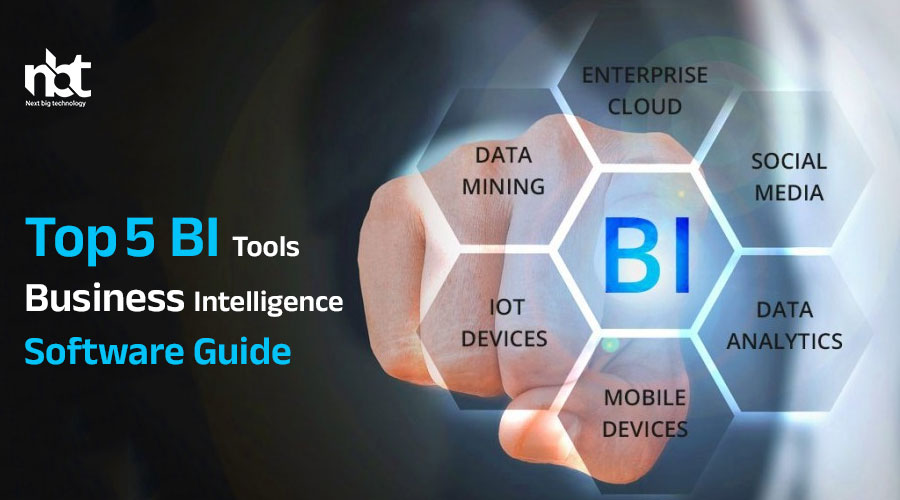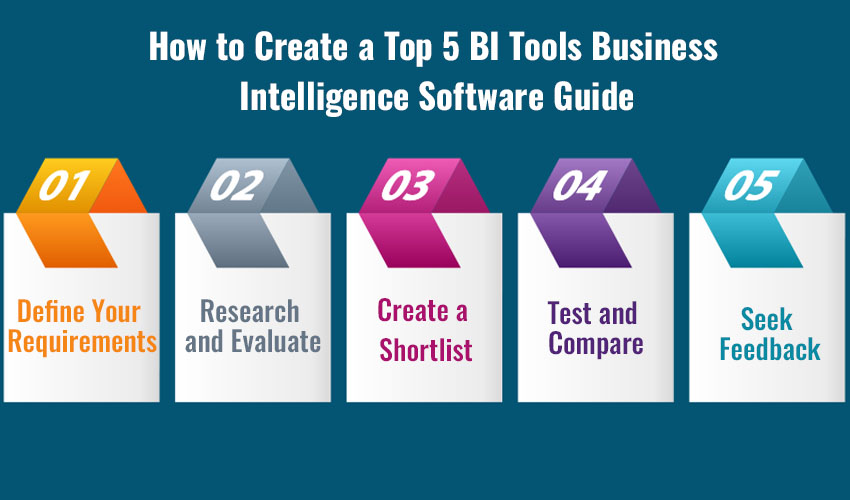Table of Contents
Top 5 BI Tools Business Intelligence Software Guide Services
Business Intelligence (BI) tools are essential for organizations looking to make data-driven decisions and gain insights into their operations. With the plethora of BI software available in the market, it can be overwhelming to choose the right one for your business. To help you navigate through the options, here’s a guide to the top five BI tools:
- Tableau: Tableau is one of the most popular BI tools known for its intuitive user interface and powerful visualization capabilities. It allows users to create interactive dashboards and reports from various data sources, including spreadsheets, databases, and cloud services. With features like drag-and-drop functionality and real-time data analysis, Tableau makes it easy for businesses to uncover insights and share them across the organization.
- Microsoft Power BI: As part of the Microsoft ecosystem, Power BI seamlessly integrates with other Microsoft products like Excel and Azure, making it a preferred choice for organizations already using these tools. Power BI offers robust data modeling capabilities, advanced analytics, and AI-powered insights. It also provides a wide range of visualization options and allows users to publish reports securely to the web or mobile devices.
- QlikView/Qlik Sense: QlikView and Qlik Sense are BI tools developed by Qlik, known for their associative data model that enables users to explore data dynamically without predefined queries. Qlik’s patented technology allows for fast and flexible data discovery, empowering users to ask ad-hoc questions and gain insights in real-time. Qlik Sense, the newer version, offers a self-service approach to BI with drag-and-drop functionality and a user-friendly interface.
- SAP BusinessObjects: SAP BusinessObjects is a comprehensive BI suite designed for large enterprises with complex data requirements. It offers a wide range of tools for reporting, analytics, and data visualization, including SAP Crystal Reports, SAP Lumira, and SAP Analytics Cloud. With support for both on-premises and cloud deployments, SAP BusinessObjects caters to organizations of all sizes and industries.
- Looker: Looker is a modern BI platform that focuses on collaboration and data-driven decision-making. It provides a centralized data model that ensures consistency across reports and dashboards, making it easier for teams to work together and share insights. Looker’s unique approach to data modeling and exploration allows users to ask natural language questions and receive instant answers, enabling faster decision-making processes.
How to Create a Top 5 BI Tools Business Intelligence Software Guide
Business Intelligence (BI) tools have become essential for modern businesses to analyze data and make informed decisions. With so many options available in the market, it can be overwhelming to choose the right one for your organization. In this guide, we’ll explore how to create a top 5 list of BI tools to help streamline your decision-making process.
- Define Your Requirements: Before diving into the selection process, it’s crucial to understand your organization’s specific needs and goals. Consider factors such as the size of your business, the volume and variety of data you deal with, your budget, and the technical expertise of your team. Determine whether you need basic reporting, advanced analytics, data visualization, or a combination of these features.
- Research and Evaluate: Once you have a clear understanding of your requirements, research the available BI tools in the market. Look for reputable vendors and read reviews from other users to gauge their performance and reliability. Consider factors such as ease of use, scalability, customization options, integration capabilities, and customer support.
- Create a Shortlist: Based on your research, narrow down your options to a shortlist of five BI tools that best align with your requirements. Consider factors such as user ratings, feature sets, pricing plans, and compatibility with your existing systems. It’s also essential to consider the long-term viability of the vendor and the tool’s roadmap for future updates and enhancements.
- Test and Compare: Before making a final decision, take advantage of free trials or demos offered by the BI tool vendors. This will allow you to get hands-on experience with the software and evaluate its functionality firsthand. Create use cases and test scenarios relevant to your business to assess how well each tool meets your needs. Pay attention to factors such as ease of use, performance, data visualization capabilities, and the availability of advanced analytics features.
- Seek Feedback: Finally, seek feedback from key stakeholders within your organization, including business users, IT professionals, and decision-makers. Gather their input on the usability, effectiveness, and overall satisfaction with each BI tool. Consider conducting surveys or holding meetings to facilitate open discussions and address any concerns or questions they may have.
Why Should You Go for Top 5 BI Tools Business Intelligence Software Guide
Business Intelligence (BI) tools have become indispensable for modern businesses looking to gain insights from their data and make informed decisions. With the plethora of options available in the market, it can be overwhelming to choose the right BI tool for your organization. However, opting for the top 5 BI tools can offer numerous benefits and streamline your data analysis process. Let’s delve into why you should consider investing in these leading BI solutions.
- Comprehensive Features: Top BI tools such as Tableau, Microsoft Power BI, QlikView, IBM Cognos, and SAP BusinessObjects offer a wide range of features designed to meet the diverse needs of businesses. From data visualization and dashboards to ad-hoc querying and reporting capabilities, these tools provide comprehensive functionalities to analyze and interpret data effectively.
- Scalability: Scalability is crucial for growing businesses, and top BI tools are designed to scale alongside your organization. Whether you’re a small startup or a large enterprise, these tools can handle large volumes of data and accommodate increasing user demands without compromising performance.
- User-Friendly Interface: One of the key advantages of top BI tools is their user-friendly interface, which makes data analysis accessible to users across the organization, regardless of their technical expertise. With intuitive drag-and-drop functionalities and interactive visualizations, employees can explore data effortlessly and derive valuable insights.
- Integration Capabilities: Integration with existing systems is essential for seamless data flow and interoperability. Top BI tools offer robust integration capabilities, allowing you to connect to various data sources such as databases, cloud applications, and spreadsheets. This ensures that you can access all relevant data within the BI platform, eliminating the need for manual data consolidation.
- Advanced Analytics: In addition to basic reporting and visualization features, top BI tools also incorporate advanced analytics capabilities such as predictive analytics, machine learning, and natural language processing. These advanced functionalities enable businesses to uncover hidden patterns, identify trends, and make predictive forecasts, empowering them to make data-driven decisions with confidence.
Market Prospects of Top 5 BI Tools Business Intelligence Software Guide and Platforms
Business Intelligence (BI) tools have become indispensable for organizations looking to make data-driven decisions and gain insights into their operations. With the increasing demand for BI software, it’s essential to understand the market prospects of the top 5 BI tools. In this guide, we’ll explore the leading BI platforms and their potential for growth and innovation.
- Tableau: Tableau has established itself as a market leader in the BI space with its intuitive data visualization capabilities. Its user-friendly interface allows users to create interactive dashboards and reports without extensive technical knowledge. Tableau’s acquisition by Salesforce has further enhanced its market presence, offering seamless integration with Salesforce’s CRM platform. With a focus on cloud-based solutions and advanced analytics features, Tableau is well-positioned for continued growth in the BI market.
- Microsoft Power BI: Microsoft Power BI has gained significant traction among businesses due to its tight integration with the Microsoft ecosystem and competitive pricing. With features like Power Query for data preparation and Power Pivot for data modeling, Power BI offers a comprehensive suite of tools for business analytics. Microsoft’s continuous investment in AI and machine learning capabilities further strengthens Power BI’s position in the market. As organizations increasingly adopt Microsoft’s cloud offerings, Power BI is poised to capitalize on this trend and expand its user base.
- Qlik Sense: Qlik Sense stands out in the BI landscape with its unique associative data model, allowing users to explore data relationships dynamically. Its powerful in-memory engine enables fast and flexible data analysis, making it a preferred choice for large enterprises with complex data requirements. Qlik’s acquisition of Attunity has bolstered its data integration capabilities, enabling seamless connectivity to various data sources. With a focus on augmented analytics and embedded BI solutions, Qlik Sense is well-equipped to meet the evolving needs of modern businesses.
- IBM Cognos Analytics: IBM Cognos Analytics offers a robust suite of BI tools designed to help organizations drive better decision-making and optimize performance. With features like AI-driven insights and natural language processing, Cognos Analytics simplifies the process of data discovery and exploration. IBM’s extensive experience in enterprise software and analytics positions Cognos Analytics as a trusted solution for businesses across industries. As IBM continues to invest in cloud and AI technologies, Cognos Analytics is expected to evolve to meet the changing demands of the market.
- SAP BusinessObjects: SAP BusinessObjects remains a dominant player in the BI market, particularly among large enterprises with SAP ERP systems. Its comprehensive suite of BI tools covers everything from reporting and dashboarding to predictive analytics and data visualization. SAP’s recent investments in SAP Analytics Cloud demonstrate its commitment to innovation and cloud-based solutions. With seamless integration with SAP’s other enterprise applications, BusinessObjects offers a holistic approach to BI and analytics. As organizations seek to leverage their SAP investments for data-driven insights, BusinessObjects is well-positioned to capitalize on this demand.
Essential Features of a Top 5 BI Tools Business Intelligence Software Guide
Business Intelligence (BI) tools have become indispensable for organizations looking to analyze and interpret their data effectively. With the vast array of options available in the market, it can be challenging to identify the top contenders. However, there are certain essential features that distinguish the top BI tools from the rest. In this guide, we’ll explore the key features that you should look for when evaluating BI software.
- Data Visualization Capabilities: One of the primary functions of BI tools is to turn raw data into actionable insights, and effective data visualization is crucial for this purpose. Top BI tools offer a wide range of visualization options, including charts, graphs, and dashboards, to help users understand complex data sets at a glance. Look for tools that allow for interactive and customizable visualizations, enabling users to drill down into the data for deeper insights.
- Advanced Analytics: Beyond basic reporting and visualization, top BI tools provide advanced analytics capabilities such as predictive modeling, machine learning, and statistical analysis. These features allow users to uncover trends, patterns, and correlations in their data, enabling them to make more informed decisions and drive business growth. Make sure the BI tool you choose offers robust analytics functionality tailored to your specific business needs.
- Data Integration: In today’s data-driven world, organizations collect data from a wide variety of sources, including databases, cloud applications, and IoT devices. A top BI tool should have strong data integration capabilities, allowing users to connect seamlessly to multiple data sources and consolidate disparate data sets for analysis. Look for tools that support both structured and unstructured data integration and offer connectors for popular data sources such as Salesforce, Google Analytics, and SAP.
- Scalability and Performance: As your business grows, so will your data requirements. It’s essential to choose a BI tool that can scale with your organization and handle increasing volumes of data without sacrificing performance. Look for tools that are designed to handle large data sets efficiently and offer features such as in-memory processing and distributed computing to ensure optimal performance, even with complex queries and calculations.
- User-Friendly Interface: Ease of use is critical when selecting a BI tool, as it directly impacts user adoption and productivity. Top BI tools offer intuitive, user-friendly interfaces that make it easy for both technical and non-technical users to access and analyze data. Look for tools with drag-and-drop functionality, customizable dashboards, and built-in tutorials or training resources to help users get up to speed quickly.
Advanced Features of Top 5 BI Tools Business Intelligence Software Guide
Business Intelligence (BI) tools have become essential for organizations seeking to leverage data for informed decision-making. These tools offer advanced features that allow users to analyze large datasets, visualize trends, and gain actionable insights. In this guide, we’ll explore the top five BI tools and their advanced features:
- Tableau: Tableau is a leading BI tool known for its powerful visualization capabilities. Its advanced features include:
- Interactive dashboards: Users can create dynamic dashboards with interactive filters, allowing stakeholders to explore data and uncover insights.
- Advanced analytics: Tableau offers built-in statistical functions and predictive analytics tools, enabling users to perform advanced analysis without the need for coding.
- Data integration: Tableau seamlessly integrates with a wide range of data sources, including databases, spreadsheets, and cloud platforms, making it easy to access and analyze data from multiple sources.
- Microsoft Power BI: Microsoft Power BI is a popular BI tool that offers a range of advanced features for data analysis and visualization. Key features include:
- AI-powered analytics: Power BI leverages artificial intelligence to provide advanced analytics capabilities, such as natural language querying and automated insights generation.
- Collaboration tools: Power BI enables users to collaborate on reports and dashboards in real-time, facilitating teamwork and decision-making.
- Data modeling: With Power BI, users can create complex data models to analyze relationships and patterns within their data, allowing for deeper insights and better decision-making.
- Qlik Sense: Qlik Sense is a self-service BI tool known for its associative data model and intuitive user interface. Advanced features of Qlik Sense include:
- Associative data model: Qlik Sense’s unique associative data model allows users to explore data dynamically, making it easy to uncover hidden insights and connections.
- Advanced visualization: Qlik Sense offers a wide range of visualization options, including interactive charts, graphs, and maps, enabling users to create compelling visualizations that enhance data analysis.
- Data storytelling: Qlik Sense includes features for data storytelling, allowing users to create narratives around their data and communicate insights effectively to stakeholders.
- IBM Cognos Analytics: IBM Cognos Analytics is a comprehensive BI platform that offers advanced features for data analysis, reporting, and dashboarding. Key features include:
- AI-driven insights: Cognos Analytics uses artificial intelligence to analyze data and generate actionable insights, helping users identify trends and patterns more quickly.
- Predictive analytics: Cognos Analytics includes built-in predictive analytics capabilities, allowing users to forecast future trends and outcomes based on historical data.
- Mobile analytics: Cognos Analytics offers mobile-friendly dashboards and reports, allowing users to access and analyze data on the go using their smartphones or tablets.
- SAP BusinessObjects: SAP BusinessObjects is a powerful BI tool suite that offers advanced features for data analysis, reporting, and predictive analytics. Key features include:
- Ad-hoc reporting: SAP BusinessObjects allows users to create ad-hoc reports on the fly, enabling them to quickly analyze data and answer business questions in real-time.
- Advanced data visualization: BusinessObjects offers a variety of visualization options, including charts, graphs, and heatmaps, allowing users to create compelling visualizations that communicate insights effectively.
- Predictive analytics: SAP BusinessObjects includes advanced predictive analytics capabilities, enabling users to forecast future trends and make data-driven decisions with confidence.
Top 5 BI Tools Business Intelligence Software Guide Timelines
Business Intelligence (BI) tools have become indispensable for organizations seeking to leverage data to make informed decisions and gain competitive advantages. With a plethora of options available, choosing the right BI software can be daunting. To simplify the process, here’s a guide to the top 5 BI tools, along with their timelines for implementation and adoption:
- Tableau: Tableau has consistently been a frontrunner in the BI market due to its user-friendly interface and powerful analytics capabilities. The software allows users to create interactive dashboards and visualizations from various data sources, enabling seamless data exploration and analysis. Implementation timelines for Tableau typically range from a few weeks to a couple of months, depending on the complexity of data sources and customization requirements.
- Microsoft Power BI: As part of the Microsoft ecosystem, Power BI seamlessly integrates with other Microsoft products such as Excel, SharePoint, and Azure. Its intuitive drag-and-drop interface makes it easy for users to create compelling visualizations and share insights across the organization. Implementation timelines for Power BI can vary, but organizations can typically expect to go live within a few weeks to a month.
- Qlik Sense: Qlik Sense is known for its associative data model, which allows users to explore data dynamically without predefined queries. With its powerful data visualization capabilities and robust security features, Qlik Sense is a popular choice for organizations looking to derive actionable insights from their data. Implementation timelines for Qlik Sense can range from a few weeks to a couple of months, depending on factors such as data complexity and integration requirements.
- SAP BusinessObjects: SAP BusinessObjects offers a comprehensive suite of BI tools designed to meet the diverse needs of businesses across industries. From ad-hoc reporting to predictive analytics, SAP BusinessObjects provides a range of functionalities to drive data-driven decision-making. Implementation timelines for SAP BusinessObjects may vary depending on the scope of the project, but organizations can typically expect to go live within a few months.
- Domo: Domo stands out for its cloud-based platform that combines BI with collaboration and data integration capabilities. With features such as real-time data alerts and mobile access, Domo empowers users to stay informed and make timely decisions from anywhere. Implementation timelines for Domo can vary depending on the size and complexity of the organization, but many organizations can expect to see results within a few months of implementation.
How Much Does It Cost to Build a Top 5 BI Tools Business Intelligence Software Guide?
Business intelligence (BI) tools have become essential for organizations looking to make data-driven decisions and gain valuable insights into their operations. With a plethora of options available in the market, it can be challenging to determine the cost of implementing a top BI tool. In this guide, we will explore the costs associated with building the top 5 BI tools.
- Tableau: Tableau is a popular BI tool known for its user-friendly interface and powerful data visualization capabilities. The cost of Tableau varies depending on the deployment option chosen. Tableau offers both a desktop and server version. The desktop version starts at around $70 per user per month, while the server version starts at $35 per user per month.
- Microsoft Power BI: Microsoft Power BI is another leading BI tool that offers robust features for data analysis and visualization. The cost of Power BI is relatively affordable compared to other tools. Power BI offers a free version with limited capabilities, while the Pro version starts at $9.99 per user per month. Additionally, Power BI Premium offers more advanced features and starts at $4,995 per month.
- QlikView/Qlik Sense: QlikView and Qlik Sense are powerful BI tools known for their associative data model and intuitive user interface. The cost of QlikView/Qlik Sense depends on factors such as the number of users and deployment options. Pricing for QlikView starts at $30,000 for a perpetual license, while Qlik Sense offers subscription-based pricing starting at $30 per user per month.
- Domo: Domo is a cloud-based BI platform that offers a wide range of features for data integration, visualization, and analytics. The cost of Domo varies depending on the size of the organization and the specific requirements. Domo offers custom pricing plans based on factors such as the number of users, data sources, and additional features required.
- Looker: Looker is a BI tool known for its advanced analytics capabilities and data modeling features. The cost of Looker is based on a subscription model and varies depending on factors such as the number of users and data volume. Looker offers custom pricing plans tailored to the needs of each organization.
How to Create a Top 5 BI Tools Business Intelligence Software Guide – Team and Tech Stack
Business Intelligence (BI) tools are essential for modern businesses looking to make data-driven decisions and gain valuable insights into their operations. With a plethora of options available in the market, it can be challenging to choose the right BI tool for your organization. In this guide, we’ll discuss how to create a list of the top 5 BI tools by considering both the team and the tech stack.
- Understand Your Business Needs: Before diving into the selection process, it’s crucial to understand your business requirements. Identify the key objectives you want to achieve with BI software. Whether it’s improving operational efficiency, enhancing decision-making processes, or gaining competitive insights, knowing your goals will help you narrow down the options.
- Assess Your Team’s Skills and Expertise: Consider the skill level and expertise of your team members who will be using the BI tools. Some tools may require advanced technical knowledge, while others offer user-friendly interfaces suitable for non-technical users. Evaluate whether your team needs extensive training or if they can quickly adapt to new tools.
- Evaluate the Tech Stack Compatibility: Compatibility with your existing tech stack is another critical factor to consider. Assess whether the BI tools integrate seamlessly with your current systems and databases. Compatibility issues can lead to data silos and hinder the effectiveness of your BI implementation.
- Research Top BI Tools in the Market: Conduct thorough research to identify the top BI tools available in the market. Consider factors such as user reviews, industry recognition, and analyst reports to gauge the reputation and reliability of each tool. Some popular BI tools include Tableau, Power BI, QlikView, Looker, and MicroStrategy.
- Compare Features and Functionality: Once you’ve narrowed down your options, compare the features and functionality of each BI tool. Look for capabilities such as data visualization, interactive dashboards, ad-hoc reporting, predictive analytics, and mobile accessibility. Assess whether the features align with your business needs and goals.
- Consider Scalability and Pricing: Scalability is essential, especially if your business is expected to grow in the future. Choose a BI tool that can accommodate increasing data volumes and user requirements without compromising performance. Additionally, consider the pricing structure and ensure it fits within your budget constraints.
- Seek Feedback and Recommendations: Don’t hesitate to seek feedback from other organizations or industry peers who have experience with the BI tools you’re considering. Their insights and recommendations can provide valuable guidance in making your final decision.
Top 5 BI Tools Business Intelligence Software Guide Process
Business Intelligence (BI) tools are essential for companies looking to analyze their data effectively and make informed decisions. With so many options available in the market, it can be overwhelming to choose the right BI software for your business. To help you navigate through the myriad of choices, we have compiled a list of the top 5 BI tools that are currently leading the industry.
- Tableau: Tableau is one of the most popular BI tools used by businesses worldwide. It offers a user-friendly interface that allows users to create interactive and visually appealing dashboards and reports. With Tableau, you can connect to various data sources, including databases, spreadsheets, and cloud services, to gather insights and make data-driven decisions. Its powerful data visualization capabilities make it easy to spot trends, patterns, and outliers in your data.
- Microsoft Power BI: Microsoft Power BI is another top contender in the BI software market. As part of the Microsoft ecosystem, Power BI seamlessly integrates with other Microsoft products such as Excel, SharePoint, and Azure. It offers a wide range of data visualization options, including charts, graphs, maps, and tables, to help you analyze your data effectively. With Power BI, you can create interactive reports and dashboards that can be easily shared with stakeholders across your organization.
- QlikView/Qlik Sense: QlikView and Qlik Sense are powerful BI tools known for their associative data model, which allows users to explore data dynamically without predefined queries. With Qlik, you can easily drag and drop data to create interactive visualizations and uncover hidden insights. Its in-memory processing engine enables fast and efficient data analysis, even with large datasets. Qlik also offers advanced analytics capabilities, such as predictive analytics and data storytelling, to help you gain deeper insights into your business data.
- Looker: Looker is a cloud-based BI platform that focuses on providing data exploration and analytics capabilities to businesses of all sizes. It offers a unique modeling language called LookML, which allows users to define their data models and metrics in a centralized repository. Looker’s intuitive interface makes it easy for users to build and customize reports and dashboards according to their specific needs. Additionally, Looker’s data governance features ensure data accuracy and security across your organization.
- Sisense: Sisense is a comprehensive BI platform that enables businesses to analyze complex datasets and derive actionable insights quickly. It offers a single-stack architecture that combines data preparation, analysis, and visualization into one seamless workflow. With Sisense, you can connect to multiple data sources, including on-premises databases, cloud services, and web applications, to create unified dashboards and reports. Its AI-powered analytics engine automates data analysis tasks and provides real-time insights to help you make faster and smarter decisions.
Next Big Technology – Your Trusted Top 5 BI Tools Business Intelligence Software Guide Partner
In today’s fast-paced business landscape, having access to accurate and timely data is crucial for making informed decisions. This is where Business Intelligence (BI) tools come into play. BI software empowers organizations to analyze data, gain insights, and drive strategic initiatives. With the rapid advancements in technology, the BI market is constantly evolving, and staying ahead of the curve is essential for businesses looking to thrive in the digital age.
If you’re on the lookout for the next big technology in BI tools, look no further. In this guide, we’ll introduce you to five top-notch BI tools that are trusted by businesses worldwide.
- Tableau: Tableau has long been a frontrunner in the BI industry, known for its intuitive interface and powerful data visualization capabilities. With Tableau, users can easily create interactive dashboards and reports, enabling them to uncover insights hidden within their data. Its drag-and-drop functionality makes it accessible to users of all skill levels, while its robust analytics features cater to the needs of even the most demanding data analysts.
- Microsoft Power BI: As part of the Microsoft ecosystem, Power BI seamlessly integrates with other Microsoft products, making it a popular choice for businesses already using Office 365 or Azure. Power BI offers a wide range of data connectivity options, allowing users to pull in data from various sources with ease. Its AI-powered features, such as natural language querying and automated insights, streamline the analytics process and enable users to derive value from their data more efficiently.
- QlikView/Qlik Sense: QlikView and Qlik Sense, developed by Qlik, are known for their associative data model, which enables users to explore data relationships dynamically. With Qlik, users can uncover insights that traditional BI tools might overlook, thanks to its unique approach to data discovery. Qlik’s patented in-memory technology ensures fast and responsive performance, even when dealing with large datasets, making it a favorite among organizations with complex analytical needs.
- SAP BusinessObjects: SAP BusinessObjects, part of the SAP ecosystem, is a comprehensive BI solution designed to meet the needs of large enterprises. With a wide range of reporting and analysis tools, SAP BusinessObjects empowers users to make data-driven decisions across the organization. Its advanced capabilities, such as predictive analytics and geospatial analysis, enable businesses to stay ahead of the competition in today’s data-driven world.
- MicroStrategy: MicroStrategy is known for its enterprise-grade BI platform, which offers a broad range of capabilities, including reporting, analytics, and mobile BI. With MicroStrategy, organizations can deploy BI applications at scale, serving the needs of thousands of users across the enterprise. Its robust security features ensure that sensitive data remains protected, making it a trusted partner for businesses operating in highly regulated industries.
Enterprise Top 5 BI Tools Business Intelligence Software Guide
In today’s fast-paced business world, data is king. Enterprises are constantly inundated with vast amounts of information from various sources, making it crucial to have robust Business Intelligence (BI) tools in place to help make sense of it all. These tools enable organizations to gather, analyze, and visualize data to gain valuable insights and make informed decisions. With a plethora of options available, choosing the right BI tool for your enterprise can be overwhelming. To help narrow down your search, here’s a guide to the top 5 BI tools for enterprises:
- Tableau: Tableau is one of the leading BI tools known for its powerful data visualization capabilities. It allows users to create interactive dashboards and reports that make it easy to explore and understand complex datasets. Tableau integrates seamlessly with various data sources, including databases, spreadsheets, and cloud services, making it ideal for enterprises with diverse data sources.
- Microsoft Power BI: As part of the Microsoft ecosystem, Power BI offers deep integration with other Microsoft products such as Excel, Azure, and SQL Server. This makes it a popular choice for enterprises already using Microsoft technologies. Power BI provides a user-friendly interface with drag-and-drop functionality for data visualization and analysis. It also offers advanced features like AI-powered insights and natural language querying.
- QlikView/Qlik Sense: QlikView and its successor Qlik Sense are known for their associative data model, which allows users to explore data dynamically without predefined queries. This unique approach enables users to uncover hidden insights and correlations within their data easily. Qlik Sense offers a modern and intuitive interface with powerful self-service capabilities, making it suitable for both business users and IT professionals.
- IBM Cognos Analytics: IBM Cognos Analytics is a comprehensive BI platform that offers a wide range of capabilities, including reporting, dashboarding, data exploration, and predictive analytics. It leverages AI and machine learning to automate data preparation and analysis, allowing users to focus on deriving insights rather than wrangling data. IBM Cognos Analytics also provides robust security and governance features, making it suitable for large enterprises with strict compliance requirements.
- SAP BusinessObjects: SAP BusinessObjects is a suite of BI tools designed to meet the diverse needs of enterprises, from ad-hoc reporting to advanced analytics. It offers a centralized platform for accessing and analyzing data from various sources, including SAP and non-SAP systems. SAP BusinessObjects provides a rich set of features for data visualization, exploration, and collaboration, making it a popular choice among enterprise users.
Top 5 BI Tools Business Intelligence Software Guide Company
In today’s rapidly evolving business landscape, data is king. To stay competitive, companies need to harness the power of their data to make informed decisions and drive growth. That’s where Business Intelligence (BI) tools come into play. These powerful software solutions enable organizations to gather, analyze, and visualize data to gain actionable insights. With so many BI tools available in the market, it can be challenging to choose the right one for your business needs. In this article, we’ll explore the top five BI tools that can help take your business to the next level.
-
-
Next Big Technology:

Focus Area
- Mobile App Development
- App Designing (UI/UX)
- Software Development
- Web Development
- AR & VR Development
- Big Data & BI
- Cloud Computing Services
- DevOps
- E-commerce Development
Industries Focus
- Art, Entertainment & Music
- Business Services
- Consumer Products
- Designing
- Education
- Financial & Payments
- Gaming
- Government
- Healthcare & Medical
- Hospitality
- Information Technology
- Legal & Compliance
- Manufacturing
- Media
-
- Microsoft Power BI: As part of the Microsoft ecosystem, Power BI offers seamless integration with other Microsoft products such as Excel, Azure, and Dynamics 365. It provides advanced analytics and AI capabilities, allowing users to uncover hidden insights within their data. Power BI also offers a user-friendly interface and a vast library of pre-built visualizations, making it easy to create compelling reports and dashboards.
- Qlik Sense: Qlik Sense is known for its associative data model, which enables users to explore data freely without predefined paths or queries. It offers powerful data visualization capabilities, allowing users to create interactive and dynamic dashboards. Qlik Sense also provides advanced analytics features such as predictive modeling and data storytelling, helping users derive actionable insights from their data.
- Looker: Looker is a cloud-based BI platform that focuses on delivering real-time insights to businesses. It offers a unique modeling language called LookML, which allows users to define data relationships and metrics in a centralized repository. Looker’s data modeling capabilities make it easy to maintain data consistency and governance across the organization. Additionally, Looker’s robust API enables seamless integration with other business applications and data sources.
- Sisense: Sisense is a comprehensive BI platform that caters to both technical and non-technical users. It offers powerful data preparation capabilities, allowing users to cleanse, merge, and transform data from multiple sources. Sisense’s In-Chip technology enables blazing-fast query performance, even when dealing with large datasets. Additionally, Sisense’s AI-driven analytics capabilities help users uncover hidden patterns and trends in their data, driving smarter decision-making.
Add Comparison Table Top 5 BI Tools: Business Intelligence Software Guide
In today’s data-driven business landscape, having access to accurate and timely insights is crucial for making informed decisions. That’s where Business Intelligence (BI) tools come in. These powerful software solutions help organizations analyze data, uncover trends, and gain valuable insights to drive growth and improve operational efficiency.
With a plethora of BI tools available in the market, choosing the right one for your business can be a daunting task. To help you make an informed decision, let’s compare the top five BI tools currently available:
- Tableau: Tableau is a market-leading BI tool known for its intuitive user interface and powerful data visualization capabilities. It allows users to create interactive dashboards and reports, making it easy to explore and analyze data. Tableau offers a wide range of features, including data blending, predictive analytics, and mobile support.
- Microsoft Power BI: Microsoft Power BI is another popular choice among businesses due to its seamless integration with other Microsoft products such as Excel and Azure. It offers robust data modeling capabilities, advanced analytics, and AI-driven insights. Power BI also provides a user-friendly interface and a vast library of pre-built visualizations.
- Qlik Sense: Qlik Sense is a self-service BI tool that empowers users to create personalized dashboards and reports without relying on IT support. It offers associative data indexing, which enables users to explore data relationships dynamically. Qlik Sense also includes powerful data storytelling features and augmented intelligence capabilities.
- Looker: Looker is a cloud-based BI platform known for its data modeling and exploration capabilities. It offers a unique modeling language called LookML, which simplifies the process of defining data relationships and calculations. Looker’s intuitive interface and collaborative features make it a favorite among data-driven organizations.
- Domo: Domo is a cloud-based BI platform that combines business intelligence with data integration and collaboration tools. It offers a wide range of pre-built connectors to popular data sources, allowing users to consolidate and analyze data from multiple sources in one place. Domo also provides real-time data alerts and notifications to keep users informed.
Comparison Table:
| Feature | Tableau | Power BI | Qlik Sense | Looker | Domo |
|---|---|---|---|---|---|
| Data Visualization | Yes | Yes | Yes | Yes | Yes |
| Data Modeling | Limited | Yes | Yes | Yes | Yes |
| Self-Service BI | Yes | Yes | Yes | Yes | Yes |
| Cloud-Based | Yes | Yes | Yes | Yes | Yes |
| Integration | Good | Excellent | Excellent | Good | Excellent |
| Collaboration | Basic | Basic | Basic | Advanced | Advanced |
| Pricing | High | Moderate | High | High | High |
FAQs on Top 5 BI Tools: Business Intelligence Software Guide
Business intelligence (BI) tools are essential for organizations looking to analyze their data and make informed decisions. With so many options available on the market, it can be challenging to determine which BI tool is the best fit for your business needs. To help you navigate through the plethora of choices, we have compiled a list of frequently asked questions (FAQs) on the top 5 BI tools.
- What are the top 5 BI tools? The top 5 BI tools currently dominating the market are:
- Tableau
- Microsoft Power BI
- QlikView
- SAP BusinessObjects
- IBM Cognos Analytics
- What features do these BI tools offer? Each BI tool offers a unique set of features, but some common features include:
- Data visualization: Creating interactive and visually appealing dashboards and reports.
- Data integration: Connecting to various data sources to consolidate information for analysis.
- Advanced analytics: Performing complex calculations and predictive modeling to gain insights.
- Collaboration tools: Sharing and collaborating on insights with team members.
- Mobile accessibility: Accessing and interacting with BI dashboards on mobile devices.
- How do these BI tools differ from each other? While all the top BI tools share similar functionalities, they differ in terms of ease of use, scalability, pricing, and specific features. For example:
- Tableau is known for its intuitive drag-and-drop interface and robust data visualization capabilities.
- Microsoft Power BI integrates seamlessly with other Microsoft products and offers a user-friendly interface.
- QlikView excels in associative data modeling, allowing users to explore data relationships easily.
- SAP BusinessObjects is renowned for its enterprise-level scalability and comprehensive suite of BI solutions.
- IBM Cognos Analytics focuses on advanced analytics and AI-driven insights.
- How much do these BI tools cost? Pricing for BI tools varies based on factors such as the number of users, deployment options (cloud-based or on-premises), and additional features. Generally, these tools offer a range of pricing plans, including free trials, subscription-based models, and enterprise licensing. It’s essential to evaluate your specific requirements and budget constraints before choosing a pricing plan.
- Which BI tool is best suited for my business? The best BI tool for your business depends on your organization’s size, industry, data complexity, and analytical requirements. It’s advisable to conduct a thorough evaluation by considering factors such as ease of use, scalability, integration capabilities, customer support, and total cost of ownership. Additionally, seeking feedback from other users and conducting hands-on trials can help you make an informed decision.
Thanks for reading our post “Top 5 BI Tools Business Intelligence Software Guide”. Please connect with us to learn more about the Top 5 BI Tools Business Intelligence.
















